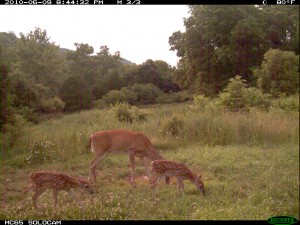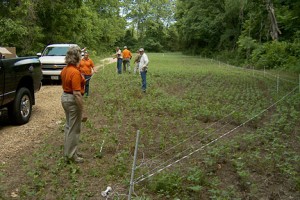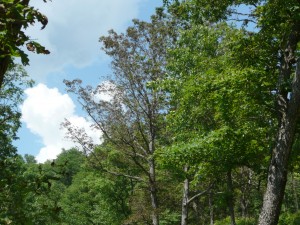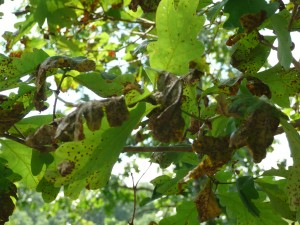Category: Uncategorized
Good Property Management Requires Practice and Training
I returned from working in New York at a property where the family that owns it has worked very hard with great skill to improve the habitat and herd. Then this morning I had a guest come to tour The Proving Grounds. I always enjoy such tours as usually the guest and I learn from each other. This guest was a professional photographer. He provided me some great hints about using light and other aspects of his trade. We toured many of the food plots, past prescribed fires, ponds, etc., at The Proving Grounds as I shared with him tips and techniques to use on his Proving Grounds in Oklahoma.
While touring, I was also able to see which food plots are doing well, which ones are showing too much browse for this time of year, etc. This allows me plan where to concentrate doe harvest efforts, plan for future food plot expansion projects, etc. It’s always obvious when touring other properties if the folks care about the property year round or only during deer season. Most properties require year round work to express their full potential. Yes, properties have potential just like bucks have potential. It requires skill and application to bring out the potential in a property so the local herd can express its potential. There are a few properties that naturally produce quality deer year after year. However, they are about as rare as a top performing athlete that doesn’t require practice or training. I enjoy owning a property that requires practice and training. I find it very rewarding to learn and see progress as a result of my efforts.
Growing Deer together,
Grant
Timely Rain
The Proving Grounds was blessed to receive ¾“ of rain on Sunday. The amount of rain a property receives is a huge factor in antler and fawn growth. This is especially true for late spring and summer months. Too much rain may cause soil nutrients to leach deep out of the reach of most forage plants. Too little rain and plants can’t transfer available nutrients in the soil to and throughout the plant.
Unless you irrigate, when and how much it rains is an uncontrollable factor in your deer management program. It’s one reason why deer herds should be managed below the habitat’s carrying capacity. By holding the deer herd’s density at the maximum capacity for the habitat to produce quality browse when ample rain is occurring means the herd will be overpopulated and damage the native vegetation at some point, because a drought will occur. It’s simply a matter of when.
Growing Deer together,
Grant
Summer Stress on Whitetails
Webster’s Dictionary defines stress as a constraining force or influence. The deer at The Proving Grounds are suffering from a constraining force or influence. Actually there are two sources of stress: heat and drought. The heat index has been over 100 degrees most days lately. Although it has rained in the area, we haven’t received enough to measure in my gauges. Some of our ponds are dry. The creek is dry except for occasional pools. This is evidenced by the hardening off of most native forage species. This in turn puts more browse pressure on the planted crops.
Trail camera images indicate that antler and fawn development to date are OK! This is due to the high quality habitat at The Proving Grounds. We planted forage soybeans early in an effort to get as much growth as possible before the hot days of summer. We’ve developed several ponds in various locations in an effort to ensure critters have enough water even during periods of drought.
We’ve managed to the extent of our budget and skill to offset periods of stress. It’s important for all managers to realize that periods of stress during the summer can be just as damaging to deer and other wildlife species as harsh winter conditions. This is one reason why it’s critical to maintain the herd’s density below the habitat’s capacity to provide quality forage, water, and cover. If the herd at The Proving Grounds had been allowed to expand to the capacity of the habitat during good conditions, the herd would really suffer during this period of stress.
Growing Deer together,
Grant
Avoid Stress on Your Deer Herd
The heat index throughout much of the Midwest and South is predicted to be over 100 degrees today. There are warnings posted for folks that work outside, the young, the elderly, etc. Clearly heat can cause huge amounts of stress on humans.
Drought can also cause stress on plants, especially new, young plants. Drought and heat stress are two of the primary reasons crops should be planted early. A soybean plant with roots a foot or more deep can survive these tough conditions much better than a soybean seedling that only has established roots a few inches deep.
Planting any forage or grain crop as soon as weather conditions are appropriate during the spring almost always results in a more vigorous plant that is more resistant to drought stress, etc. The end result will be a larger yield of forage and or grain.
The same is true for fawns. A heat and drought combination  is very rare during the normal fawning season throughout most of the whitetail’s range. However, droughts can cause significant mortality among late born fawns. Droughts directly affect plant growth and nutritional quality, which impacts the quantity and quality of milk produced by does, etc. Drought can reduce the population of prey species which concentrates predation on the surviving prey species, etc. Fawns born during the normal time-frame have a much better chance of surviving the harsh conditions of a summertime drought. This is just one of many reasons responsible deer managers should ensure a herd’s adult sex ratio is in balance.
is very rare during the normal fawning season throughout most of the whitetail’s range. However, droughts can cause significant mortality among late born fawns. Droughts directly affect plant growth and nutritional quality, which impacts the quantity and quality of milk produced by does, etc. Drought can reduce the population of prey species which concentrates predation on the surviving prey species, etc. Fawns born during the normal time-frame have a much better chance of surviving the harsh conditions of a summertime drought. This is just one of many reasons responsible deer managers should ensure a herd’s adult sex ratio is in balance.
Like planting crops during the appropriate time, ensure fawns are born during the appropriate time by planning a deer harvest that results in a balanced adult sex ratio. The yield of the resulting fawn crop will be better.
Growing Deer together,
Grant
Managing Food Plots for Hunting Season
I enjoyed a great tour of The Proving Grounds Sunday afternoon with my friend, Robin Fisher. It has been two weeks since the three Gallagher food plot protection systems have been installed. There is already an amazing difference in the height and density of Eagle Seed beans inside compared to outside the fencing systems in the two smaller plots. In fact, Robin and I immediately began strategizing about stand/blind locations to capitalize on the forage that I can make available when hunting conditions are right this fall. This will be a very interesting project to monitor throughout the summer and will certainly be a great stop during our fall field day (date to be announced).
Field days at The Proving Grounds are simply a day for serious hunters and land managers to get together and learn from each other. We’ll tour The Proving Grounds and discuss all of our habitat and hunting strategies. I enjoy sharing and learning with other folks and such tours are a great way to see, touch, and experience our successes and failures.
Growing Deer together,
Grant
Gobbling in June
Today is June 11th (my birthday). It’s the first time I remember hearing multiple gobblers on my birthday in southern Missouri. Gobblers were rattling the hills this morning. I love the sound of gobblers, but I’m saddened at why I’m hearing multiple gobblers this time of year. This is an indication of failed turkey nesting success during the normal time requiring an extended breeding season. An extended breeding season requires much more energy and increases the amount of time turkeys are very vulnerable to predators. Gobbling and strutting activities means toms are not fully alert to predators. Hens are very vulnerable to predators while nesting.
I strongly suspect an abundance of predators contributed to the amount of nest failure that apparently occurred this spring. The National Weather Service reports 2.5” more than normal rain occurred during May in my neighborhood. There were no major flood events, etc. We simply had a few more showers. There have been years when conditions were much worse. These years occurred during a time when Missouri’s turkey population was much higher.
Many states allow trapping and predator control during fawning/nesting season. Missouri doesn’t. My traps are in the barn and predators are removing turkeys. There is no shortage of raccoons throughout most regions. It is well published that Missouri’s turkey population has declined in recent years. It seems to me something is out of balance.
Certainly the past few springs have not been ideal nesting conditions due to rainy and cold weather. However, I don’t think predator control should be totally discounted. I understand predator/prey relationships and cycles. I spend the vast majority of my time creating quality habitat including nesting and brooding habitat. I always recommend land owners focus the majority of their resources on habitat management.
With that said, I’m saddened more states don’t permit predator management during the nesting/fawning seasons. It’s simply a tool for wildlife management. It is not a cure, and has limited value without first developing quality habitat. However, it is a tool that shouldn’t be taken away.
I’m not a quail hunter, but I really enjoy hearing quail. I’ve yet to hear a single quail this spring at my place. I have literally 1,000’s of trail camera images of raccoons, opossums, coyotes, and bobcats that were taken during the past month. My family would rather hear a turkey or quail than see an opossum. How about yours?
Growing Deer together,
Grant
53 Acres of Food Plots in North Carolina
I’ve been establishing 53 acres of food plots on a new project in coastal North Carolina. 20+ years of harvest data on this property has been accumulated and I am extremely interested to see how body weight, antler development, and fawn recruitment responds to 50+ acres of soybeans. Our food plot establishment on this project consisted of applying Glyphosate, using a no-till drill, planting 70 lbs. per acre of soybeans, and applying an appropriate amount of fertilizer. We received the go ahead on this project June 1st so the plots were established a little late. Their success will be primarily dependent upon adequate soil moisture now throughout the rest of the summer.
Growing Deer together,
Grant
Creating Super Hunting Spots
I had a very enjoyable day in the field yesterday. I helped install food plot protection fences around portions of three food plots where Eagle Seed beans have recently been planted.  These are hunting plots. They are small enough for deer to be comfortable using during daylight hours as long as hunting pressure is minimal. Currently there are about 75 deer per square mile at The Proving Grounds, so the local herd can damage newly established soybeans crops in relatively small plots. By protecting the soybeans until they mature or hunting season opens is like placing a candy bar in view of my children but telling them “not yet.” When the food plot protection fence is taken down, the deer will come dine just as fast as telling my kids “Ok, you can have the candy bar now!”
These are hunting plots. They are small enough for deer to be comfortable using during daylight hours as long as hunting pressure is minimal. Currently there are about 75 deer per square mile at The Proving Grounds, so the local herd can damage newly established soybeans crops in relatively small plots. By protecting the soybeans until they mature or hunting season opens is like placing a candy bar in view of my children but telling them “not yet.” When the food plot protection fence is taken down, the deer will come dine just as fast as telling my kids “Ok, you can have the candy bar now!”
I’ve placed some trail cameras near the food plot protection fences and will be posting images and video of this project throughout the summer – while waiting for September 15th – opening of bow season in MO!
Growing Deer together,
Grant
Jumping Oak Gall
About seven days ago I noticed a mature white oak tree at The Proving Grounds with leaves that were brown, curled and appeared to be dying. This was a very unusual observation for late May. The oddity of the observation and the fact that it was a white oak made me a bit sad. The timber on The Proving Grounds was grossly mismanaged before I purchased the property and as a result there are very few mature white oaks. However, I know that trees age, get sick, are struck by lightning, etc., and die.
I was very suspect when I returned to that portion of the property a day later and noticed another mature white oak tree in the same area with brown leaves. In less than a week, all leaves had fallen from the original tree and several more white oaks on the same hillside had brown leaves.
I prefer that deer at The Proving Grounds consume better quality food than acorns, but these trees were stately and very attractive. There are no food plots on this hillside and it hadn’t been burned in two years. Realizing I needed help diagnosing the problem I called a friend, Randall Roy with the Missouri Department of Conservation. Randall manages several thousand acres of public land about an hour east of The Proving Grounds. He called a forester at the Missouri Department of Conservation that stated his “phone had been ringing constantly this morning.” To their credit, the Department had already mobilized some experts to identify the cause of this phenomenon that had been reported over a several hundred mile area. Jumping oak gall is the early diagnosis.
Jumping oak galls are produced by gall wasps. According to Johnson and Lyon (Insects That Feed on Trees and Shrubs, 1991, page 440), as the larva inside of a gall matures, the gall falls to the ground. The gall then “jumps” repeatedly a few centimeters because of the activity of the insect inside. I researched jumping oak gall and learned that most trees that have jumping oak gall survive. I hope the authors are correct. It’s tough to see beautiful trees become totally defoliated during prime growing season.
It seems I’m constantly being taught new lessons. I’ve driven by this grove of mature white oaks hundreds of time during the past eight years. I thought frequently about hunting in or near them. A professional photographer friend of mine, Michael Engelmeyer, has taken multiple print ad and magazine cover images near these trees. I’ve watched turkeys fly up and down from them. I used prescribed fire to manage around them. It never crossed my mind that I might out live them. I hope I learn to not take natural beautiful spots for granted, even though I work outdoors constantly. I hope they survive.
Growing Deer together,
Grant
Planting Corn, Fighting Wireworm
Today is another day of learning at The Proving Grounds. I checked all the corn food plots on the property yesterday afternoon. The best stand of corn has a maximum of 30% of the population that it should (we planted about 26,000 kernels per acre). The culprit is wireworm. Wireworms live 3-6 years, are about 1’ long, brownish in color, segmented and they live to eat the carbohydrates out of the middle of a grain of corn. This kills the grain of corn and prohibits germination. I took a screwdriver and dug down several yards of drill rows where the corn was planted. There was simply no seed corn to be found. Suspecting this ahead of time (based on problems last year), I had already obtained enough corn to replant the plots after treating it with a much higher level of insecticide. This insecticide doesn’t harm the corn or beneficial insects (like earthworms) that might pass by the kernel. It only kills the pests that eat the corn.
Today we sprayed most of the existing corn with Gramoxone to remove any volunteer crops. This may sound counterintuitive but volunteer crops are unwanted because of how closely together the plants usually grow. Seedling corn simply views any other corn seedlings, beans, etc., as competition (weeds). Gramoxone herbicide is a surface killer. That is to say it is not active in the soil. We couldn’t use Glyphosate as the volunteer corn and beans are Roundup Ready. Because Gramoxone is only surface active, we literally unhooked the sprayer and attached the no-till drill. Brad is planting corn as I write this update.
The soil temperature is warm and there is plenty of soil moisture, so we should know by next week who wins round two (us vs. wireworms). I’ll keep you posted so you won’t have to learn this lesson the hard way.
Growing Deer (and learning) together,
Grant





